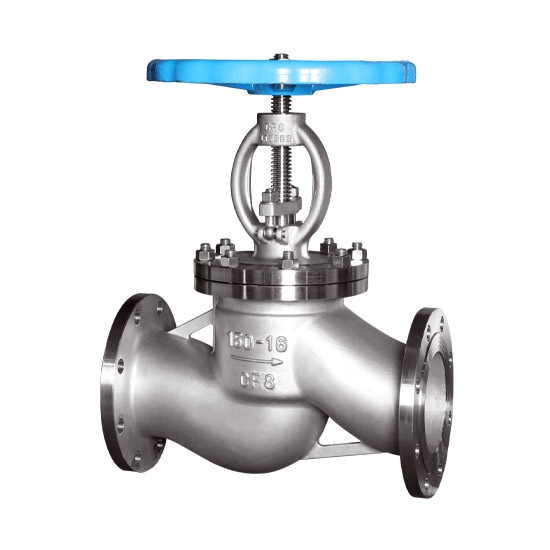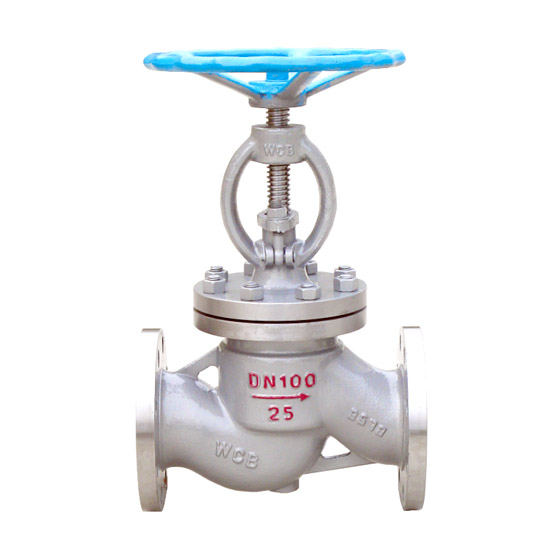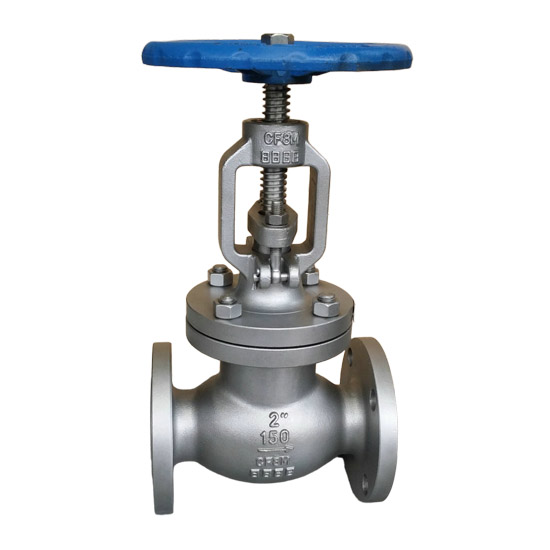I. Product Overview
1. Features
The National Standard Stainless Steel Flanged Globe Valve is a shut-off valve that controls medium flow by vertically lifting or lowering the disc along the stem. It is integrated into pipeline systems via flanged connections. Key features include:
• Body-Seal (Type W) Design: The sealing surfaces of the disc and seat are formed directly by machining or overlaying hardened layers on the stainless steel body (e.g., J41W-P type), ensuring zero-leakage sealing performance under high temperature and pressure for weak to strong corrosive media such as nitric acid, acetic acid, and urea solution.
• Unidirectional Flow Adaptability: Medium flow must strictly follow the arrow marked on the valve body (low-in, high-out — inlet below the disc, outlet above), ensuring that medium pressure assists sealing during closure.
• Rising Stem Drive System: The stem is fully exposed and moves with the disc (trapezoidal thread drive). The number of handwheel rotations intuitively indicates valve opening (fully open → stem at top; fully closed → stem at bottom).
• Compact and Efficient Structure: Straight-through flow path design (higher flow resistance but strong shut-off capability), suitable for full open/full close operation. Not recommended for throttling or flow regulation.
• Corrosion Resistance Advantage: Valve body/bonnet made of stainless steel such as 304 (J41W-P) or 316L (J41W-R), significantly improving resistance to chloride ions, organic acids, and stress corrosion.
2. Model and Coding System
Example: J41W-16P
• J: Globe valve type • 4: Connection type (flanged; common alternatives: welded – J61W, threaded – J11W) • 1: Structure type (straight-through single disc; angle type is J44W) • W: Sealing surface material (body-sealed stainless steel; others include Y – Stellite alloy, H – stainless steel overlay) • 16: Nominal pressure (PN16, 1.6 MPa) • P: Body material (CF8 stainless steel; other options: R – 316L stainless steel, I – chrome-moly steel, C – carbon steel)
Other common models:
• J941W: Electric actuated type • J641W: Pneumatic actuated type • J40W: Socket weld end (requires matching flange) • J41F: PTFE-lined corrosion-resistant type (for strong corrosive media such as organic solvents)
II. Main Technical Parameters
1. Pressure Rating and Test Standards
• Nominal Pressure (PN): PN1.6~PN16.0 MPa (Class 150~1500) • Strength Test Pressure: 1.5×PN (≥15 min pressure holding without deformation or leakage; e.g., PN16 = 2.4 MPa hydrostatic) • Sealing Test Pressure: 1.1×PN (≥15 min bidirectional pressure holding without leakage; e.g., PN16 = 1.8 MPa air/water) • Test Standards: Strictly comply with GB/T 13927 (general valve pressure test), JB/T 9092 or equivalent international standards to ensure long-term sealing and structural integrity
2. Applicable Operating Conditions
• Operating Temperature: – Standard stainless steel sealing surface (304/316L): -29℃ ~ +200℃ (recommended upper limit for nitric/acetic acid) – Hardened stainless steel overlay: -29℃ ~ +425℃ (compatible with high-temperature steam/oil)
• Applicable Media: Water, steam, oil, weakly corrosive liquids (nitric acid ≤200℃, acetic acid ≤200℃), natural gas, urea solution
• Body/Bonnet Materials: CF8 (304 SS), CF8M (316 SS), CF3M (316L low-carbon SS) • Disc/Seat Sealing Surface: Hardened stainless steel body (Type W) or overlay (optional H/Y type for enhanced wear resistance) • Stem Material: Nitrided 2Cr13 stainless steel (anti-scuffing and corrosion-resistant), 304/316L (for highly corrosive conditions) • Packing Seal: Braided flexible graphite (for high-temperature steam) or reinforced PTFE (high chemical compatibility) • Flange Standards: GB/T 9113 (Chinese RF raised face flange), ASME B16.5 (optional American standard)
3. Structural Dimensions
• Nominal Diameter: DN15~DN400 mm (larger sizes customizable) • Face-to-Face Length: Strictly matches GB/T 12221 • Full bore flow path design optimized for flow resistance, though resistance coefficient remains higher than gate valves (≈10×)
III. Structure and Working Principle
1. Body-Seal Mechanism
• Hardness Differential Pairing: Disc and seat use hardened stainless steel body surfaces (seat hardness slightly higher, HRC38~45) to reduce scuffing risk. Dual sealing via forced wedge fit + medium pressure self-tightening ensures zero leakage (low pressure relies on handwheel torque; high pressure relies on medium thrust to assist downstream sealing).
• Elastic Compensation Advantage: Disc center allows slight deformation to adapt to thermal expansion/contraction or installation deviation. After long-term wear, seat flatness can be restored by grinding (flatness ≤0.02 mm/m)
2. Rising Stem Drive System
• Visual Opening Indication: Exposed stem length directly reflects disc position (fully closed → stem retracted; fully open → stem at top)
• Trapezoidal Thread Drive: Handwheel rotation converted to linear stem motion via nut; worm gear mechanism used for DN ≥200 valves to reduce operating torque
• Triple Sealing Protection: Flexible graphite packing + metal bellows ring + gland design significantly reduces stem leakage under high temperature and pressure
3. Opening and Closing Process
• Opening: Counterclockwise rotation of handwheel raises stem, disc lifts off seat, flow path opens (flow resistance coefficient ≈16~20, higher than gate valve)
• Closing: Clockwise rotation lowers disc to seat, forced wedge fit + medium pressure self-tightening shuts off medium. After full opening, reverse 1/4~1/2 turn to compensate thermal expansion and prevent stem lock-up (especially in high-temperature steam conditions)
IV. Technical Standards
1. Compliance Standards
• Design Codes: GB/T 12235 (steel globe valves), ASME B16.34 • Test Standards: GB/T 13927, API 598 • Connection Standards: GB/T 9113 (Chinese flange), ANSI B16.5 • Special Certifications: – NACE MR0175 (sour gas resistance, suitable for H₂S-containing natural gas) – ATEX (explosion protection) – CRN (Canadian pressure vessel registration)
Hot Tags: globe valve /




